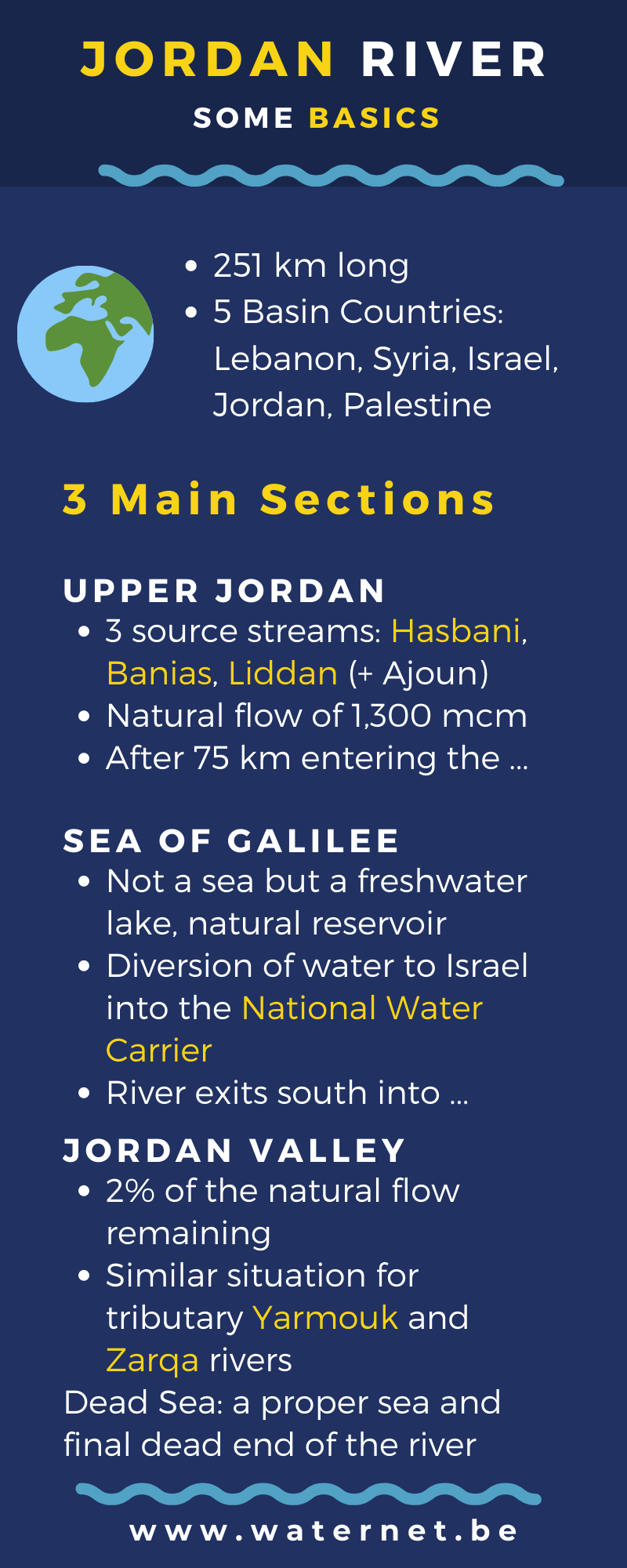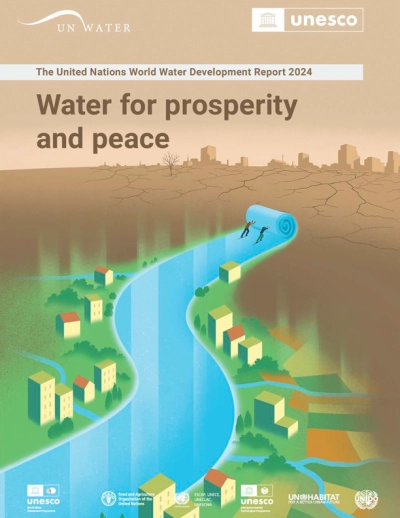Political hydrography of the Jordan River
- Written by Stefan Deconinck
In this section, we will present a brief sketch of the hydropolitics involved in the water resources of the Jordan Basin, together with some references to literature.
[UNDER CONSTRUCTION: more information needs to be added to explain the situation on the ground; e.g. separate pages on the National Water Carrier, the King Abdullah Canal, the situation on the border of Israel-Lebanon-Syria, the Israeli-Jordanian peace agreement of 1994, the agreements between Israel and the Palestinian Authority; Links to locations on satellite imagery and other illustrations; Literature references]
The hydropolitics and withdrawal of water from the river are a key feature in the geopolitical constellation of this region, which incudes the continuing belligerent situation between Israel and Lebanon and Israel and Syria since 1948, the annexation of the Syrian Golan Heights by Israel, the occupation of the Palestinian West Bank by Israel and its policy of settlement and appropriation of agricultural land, and the relations between Jordan and Israel based on the 1994 peace agreement.
Upper Jordan sub basin
Usually, three streams are identified as the sources of the Jordan River: Hasbani, Banias and Liddan (Dan).
- The Hasbani is a seasonal stream. Its spring is located near the town of Hasbaya in the south of Libano; a quick look at images from Google Earth also learn that it is fed by surface water from the slopes of the Mountain of the Sheikh (Jabal al Sheikh, Mount Hermon). The Hasbani flows southwest and southwards from Hasbaya, follows the Syrian-Lebanese border from the town of Ghajar and then after a few kilometers crosses into Israel. The eastern shore at Ghajar is part of the Golan Heights territory, occupied by Israel since the war of 1967 and formally annexed in 1981. Just north of Ghajar, in Lebanon, the Hasbani is joined by the Wazzani, a permanent stream over which an incident emerged in the summer of 2002 - as an illustration of the sensitivity of the geopolitics of water.
- The sources of the Banias are located on the Syrian Golan Heights. Israeli annexation of the territory gives it full control over surface water and groundwater resources that feed the sources of the Banias. Settler communities exploit the water for agriculture and industry, which is not allowed under international law.
The Banias flows southwest, crosses the border of Israel and joins the Liddan (Dan). - The Liddan springs are located in Israel, just a few meters from border with the Syrian Golan Heights. The springs are fed by surface water and groundwater from Syrian territory, especially the so-called Shebaa farms in the Golan Heights. Also here, settler communities exploit the water for agriculture and industry.
The Liddan (Dan) river meets the Banias just before joining the Hasbani near the Israeli town of Sde Nechemja; from here the river is called Jordan River.
Flowing south, the Jordan passes through what remains of the Hulah marsh lands, which were drained in in the 1950s to make place for irrigated agriculture - before the river continues south and enters Syrian territory before it finishes its journey as a border river between Israel and Syria and enters the Sea of Galilee at its northern tip.
Sea of Galilee
The Sea of Galilee, a sweetwater lake also called Sea/Lake Tiberias or Kinneret, is clearly not a sea but a freshwater lake, with Israel and Syria (Golan Heights) as riparians, on the western and eastern half respectively. The natural outlet of the lake in the south is dammed at Degania to most of the water from leaving the lake, turning the lake in a huge reservoir. The water is then diverted into the National Water Carrier [create page], a network of pipes, canals an pumping stations, and carried outside the Jordan River basin, towards the Israeli coastal plain and the northern Negev desert; growing demand in these areas lead to over-pumping, threatening the sustainability of this freshwater body but also leaving no water for other riparian users.
[section to be added: desalination in Israel and the potential reversal of the flow of the National Water Carrier to preserve the Lake of Galilee and the lower Jordan basin]
Lower Jordan sub basin
The dam in Degania allows for less than 2% of the natural flow to pass the outlet of the lake. About 10 km further south, the Jordan River is joined from the east by the Yarmouk River [create page]. This river has its catchment area mainly Syria and Jordan. Just as Israel prevented downstream riparian from benefeting from the water from the Jordan River, Syria and Jordan are maximising their benefit from the water from the Yarmouk River. When Jordan and Yarmouk join, the absolute minimum amount of water is left in the river beds of both rivers. Jordan benefits from the diversion of water from the Yarmouk towards its side of the Jordan Valley through the King Abdullah Cana [create page]l, running parellel to the Jordan River. Syria maintains a huge irrigated agricultural area east of the Golan Heights, taking the largest share of the Yarmouk river [create page].
As the remains of the Jordan River continue to travel southwards, the river forms the border between Israel and Jordan and -further south- the border between the occupied Palestinian West Bank and Jordan. On that western bank, the Palestinians are banned from accessing the Jordan valley and have no right to its water resources, and only limited rights to the groundwater resources of the Mountain Aquifer [create page]. On the other hand, Israeli agricultural settlements [create page], which are illegal under international law, benefit from the occupation of the land and almost unrestricted exploitation of its resources. East, on the Jordanian side of the river, streams like Zarqa River [create page] run dry in the valley.
When Jordan and Israel signed their peace agreement in 1994 [create page], they settled for a status quo on access to water. Palestinians have no sovereingty over the water resources of the West Bank (surface water and groundwater) [create page]; their access is restricted and under surveilance of the Israeli military authorities.
Finally, the river reaches its end, at the lowest point on land near the Palestinian town of Jericho. Here the last buckets of heavily polluted, brackish water find their way into the Dead Sea [create page].
Fact sheet groundwater extraction in Jordan
- Written by Stefan Deconinck
This map from the 2017 annual report by the Water Authority of Jordan (WAJ) shows the different groundwater basins in Jordan. Except for 2 basins in the eastern and southeatern part of the country, all the groundwater basins are being over-exploited, with abstraction exceeding their safe yield. This is especially the case for the Zarqa basin and Azraq basin (serving the cities of Amman and Zarqa, at a rate of 188% and 290% of the safe yield resectively). This practice will without doubt affect the quality (risk of contamination and pollution) and the renewability of the water resources.
Additionally, this map clearly suggests that the groundwater basins should be considered as transboundary water resources, which are also being exploited across the border, like the Disi Aquifer.
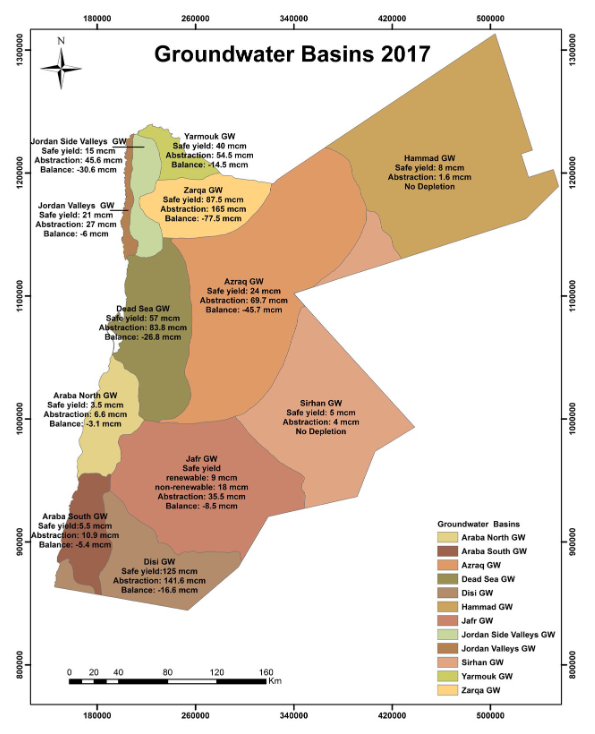 Jordan groundwater basins, from on Ministery of Water and Irrigation 2017
Jordan groundwater basins, from on Ministery of Water and Irrigation 2017
Source: Water Authority of Jordan (WAJ), Jordan Water Sector - Facts and Figures 2017.
A similar map below from an article in Nature (2019):
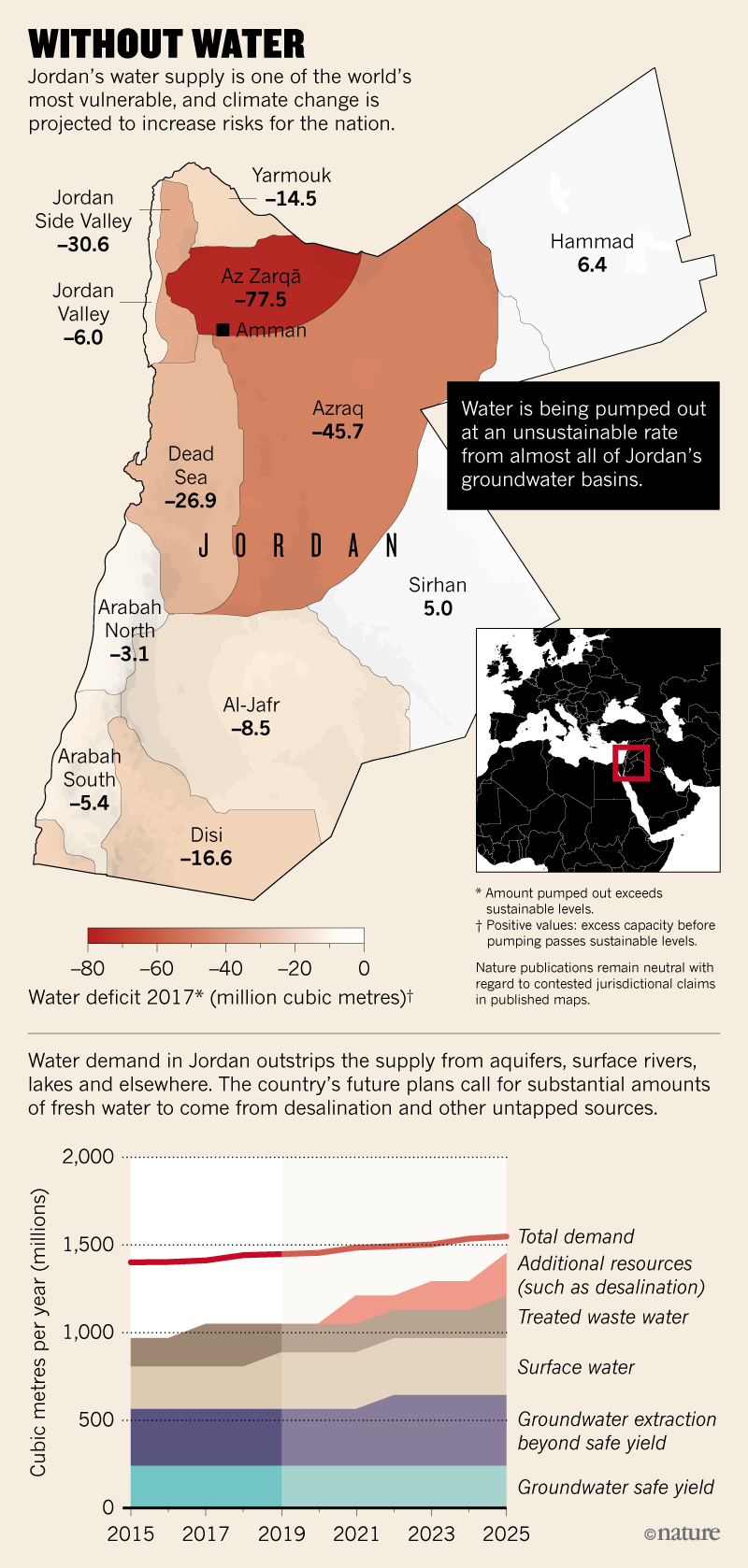 Jordan groundwater basins and water use, Nature 2019
Jordan groundwater basins and water use, Nature 2019
Source: Nature. 2019 (A land without water: the scramble to stop Jordan from running dry, https://www.nature.com/articles/d41586-019-02600-w).
Fact sheet water resources in Jordan: availability, use, access
- Written by Stefan Deconinck
This is an annotated collection of some figures on water availability, water use and access to water in Jordan.
Main challenges
- Water availability:
- Renewable water resources under severe stress
- Few alternatives available; at high cost
- Pollution: 20% of household wastewater unsafely discharged, affecting water natural water resources
- Climate change and environmental change threatens the hydrological cycle
- Water demand:
- Population growth higher than expected (Syrian refugee crisis)
- Demand is higher than renewable water resources
- Water consumption:
- 47% of water withdrawal is unaccounted for (490 million m3 or water for 4.7 million people)
- More than half of total water consumption creates only 5% of national added value
Available freshwater resources
Internal renewable resources:
- Long-term average annual percipitaton: 9.915 km3 (estimated)
- Total internal renewable water resources: 0.682 km3.
This is the amount of percipitation that feeds into the flow of rivers and recharges groundwater and aquifers. - Note that from the figures above, we can conclude that 93% of the rainfall in Jordan almost immediately evaporates or evapotranspirates into the atmosphere and doesn't reach the main surface water or groundwater systems.
Transboundary water resources:
- External renewable water resources (inflow from upstream countries, shares of border rivers and lakes): 0.165 km3
- Note that the total flow from border rivers is 0.54 km3, of which Jordan may use 0.035 km3 or less than 10%.
Border rivers are the Yarmouk and Jordan River.
- Note that the total flow from border rivers is 0.54 km3, of which Jordan may use 0.035 km3 or less than 10%.
- Groundwater entering the country: 0.27 km3
In sum: total available renewable freshwater resources in Jordan:
- 0.937 km3
- which is 95.75m3 per capita per year.
- Available water resources are not the same as exploitable resources. The latter are considered to be available for development, taking into consideration factors such as: the economic and environmental feasibility of storing floodwater behind dams, extracting groundwater, the physical possibility of storing water that naturally flows out to the sea, and minimum flow requirements (navigation, environmental services, aquatic life, etc) - (definition by Aquastat). Thus the amount of exploitable resources will be lower than the available water resources; we are still looking for usefull figures.
Source: FAO (2017), AQUASTAT Core Database. Database accessed on 22/02/2021.
Water use
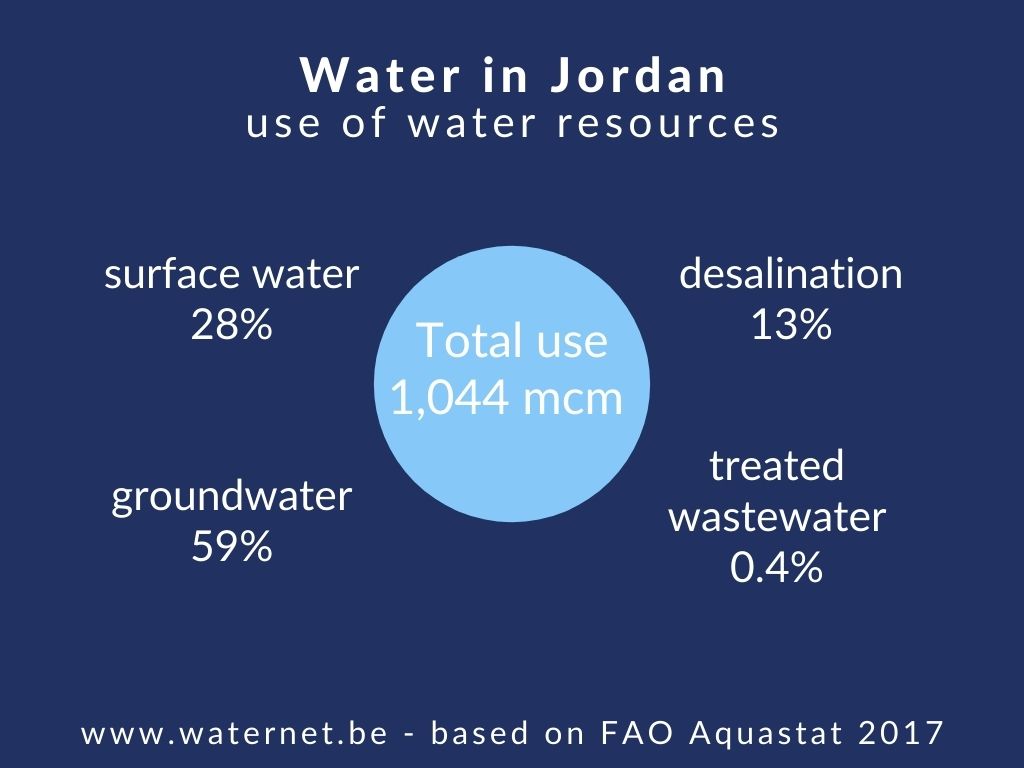 Total water use for human development (agriculture, industry, municipal) is 1.044 km3 or 1,044 million m3.
Total water use for human development (agriculture, industry, municipal) is 1.044 km3 or 1,044 million m3.
This is the amount of water that is taken out of the natural environment and artificial storage systems, from non-renewable groundwater resources, re-used drainage and wastewater or desalinated water.
This is 109% of the amount of available renewable freshwater resources (once we have the data, it will be better to compare it with the exploitable resources).
If we look more into detail, withdrawal from surface water is 288,8 million m3, and groundwater (renewable and non-renewable) is 614,8 million m3, or 903.6 million m3 in total. Desalination (136.3 million m3) and re-use of treated wastewater (4.2 million m3) are non-conventional water resources.
Read also more in the fact sheet on groundwater extraction in Jordan.
Average water use: 103 m3 per person (population size of 10.1 million in 2019).
With a score of 4.56 on the Water Stress Index, Jordan is the 5th most water stressed country in the world (See: World Resource Institute, Aqueduct country rankings).
Withdrawal per sector and relative efficiency
Of the total withdrawal of 1,044 million m3, agriculture is the biggest consumer of water in Jordan; it takes more than half of the water withdrawal but adds just 5% to the national wealth. In comparison, industry, with 3.1% adds 61% to national wealth.
Source: FAO (2021), AQUASTAT Core Database. Database accessed on 22/02/2021; UN Water (2021), Sustainable Development Goal 6 - Jordan.
Valuing water
- 47% of water in Jordan is non-revenue (leakage, unauthorized connections, and unpaid bills). This is cost that has to be absorbed by the water utilities and eventually passed to paying clients.
- The Ministry of Water and Irrigation is implementing a capital investment program on a yearly basis that costs around USD 400 million per year for rehabilitation of infrastructure, reduction of non-revenue water, and developing new water resources.
- The price for municipal water for households in Amman is 0.37 JD per m3 (US $0.52), which is very cheap regarding the national water crisis. It is not clear what the real production cost for municipal water is, but at this price water must be subsidised.
- The price for water delivery by (private) truck in Amman is 2 JD ( US$2.82) per m3 or 440% the price for municipal water.
Source: Ministery of Planning and International Cooperation, Jordan response plan for the Syria crisis 2020-2022; my monthly water bill (March 2021); my friend's water bill (March 2021).
[UNDER CONSTRUCTION: access to water - drinking water - sewage facilities (SDGs)]
Links to additional existing data sheets:
- Sustainable Development Goal 6: Jordan fact sheet (UN Water)
- FAO AQUASTAT - Jordan country profile
Fact sheets
- Written by Stefan Deconinck
Data on and references to water resources and management in the Jordan River basin
[This section is under construction]
- An introduction: the political hydrography of the Jordan River Basin
Our own fact sheets:
Jordan
- Fact sheet water resources in Jordan: availability, use, access
- Water management and policies in Jordan: fact sheet
We are still preparing similar fact sheets on Israel, Lebanon, Palestine, Syria
Some links to external data resources on Jordan Basin countries:
- UN Water: Sustainable Development Goal 6
- FAO-AQUASTAT country profiles
Palestinian water resources under occupation
- Written by Stefan Deconinck
[Under construction]
- World Bank (2009): West Bank and Gaza - Assessment of restrictions on Palestinian water sector development.
The goal of the assessment is to develop a balanced analysis and create awareness of the factors restricting Palestinian water sector development as well as of the economic, social, and environmental impacts of these restrictions. The assessment addresses factors such as sector governance, and movement and access (M&A) restrictions beyond the control of the Palestinian Authority, as well as internal contributing factors, notably governance and capacity weaknesses of Palestinian institutions.
Water management and policies in Jordan: fact sheet
- Written by Stefan Deconinck
Institutions for water management and water resources in Jordan
- Ministry of Water and Irrigation
The Ministry of Water and Irrigation (MWI) is the official body responsible for the overall monitoring of the water sector, water supply and wastewater system and the related projects, planning and management, the formulation of national water strategies and policies, research and development, information systems and procurement of financial resources. Its role also includes the provision of centralized water-related data, standardization and consolidation of data. (from the Ministery website)
- The Water Authority of Jordan (WAJ) is in charge of water & sewage systems
- The Jordan Valley Authority (JVA) is responsible for the socio-economic development of the Jordan Rift Valley, including water development and distribution of irrigation
Policies and strategies
Several water strategies and related development strategies have been published on different websites. We file these documents off-line, in case links to their original location are broken
- MWI, National Water Strategy (2016-2025)
- MWI, National Water Strategy (2008-2022) (published 2009). See also a summary of the strategy on UNEP.
- MWI, Jordan's water strategy and policies, 2004
- Water strategy for Jordan, 1997
- Ministry of Planning and International Cooperation, Jordan Response Plan for the Syria Crisis 2020-2022, contains references to national water security.
- Ministry of Environment, A national green growth plan for Jordan, 2017.
Status: the plan is not yet adopted as government policy.- Interesting: indicators for monitoring and measuring green growth, page 137 (figure 6.2), including water related indicators.
- Interesting: turning a threat into opportunity: "The green growth opportunity in Jordan is clear. The benefits of pursuing green growth can far outweigh the costs of implementation, with Jordan’s national circumstances (e.g. lack of fossil fuels and water resources) making it unusually well positioned to seize opportunities."
- Jordan 2025 - A national vision and strategy - 2018 (Part 1 and Part 2). Also called "Vision 2025".
"The Vision 2025 document emphasises the imbalance between water demand and available resources." - Regional NGO Master Plan for Sustainable Development in the Jordan Valley (2015).
This plan has been proposed to the governments of Israel, Jordan and Palestine; adopted upto now only by Jordan.
Examples of actions
- GIZ, Efficient and sustainable management of water resources in Jordan (2019-2021)
- From the Who’s Who in Jordan’s Energy, Water & Environment (EWE) website: actions as part of the 2016-2025 strategy:
"The water investment capitalizes on areas of improvement according to the government’s Water Strategy to encourage efficient use of natural resources, to augment water supply, to expand wastewater treatment and to minimize water losses. The current five prospective investment opportunities are:
1. Aqaba-Amman National Conveyance project (AAWDC Project): To enhance the Kingdom’s national water security by producing potable water through desalination at the Gulf of Aqaba and transferring 150MCM/Year of additional water to Amman.
2. As Samra Treatment Plant (3rd phase/2nd expansion): To expand the capacity of the plant by an additional treatment capacity of 100,000 CM per day and to establish a solar power plant with 10 MW capacity.
3. Non-Revenue Water (NRW) Reduction: To reduce physical and commercial water losses in Amman.
4. Hisban Brackish Water Desalination 10-15 MCM/Year: The project aims to augment water sources by 10-15 million cubic meters per year (through the drilling of 10 wells) and to develop solar energy to provide about 15MW.
5. Al Ghabawi Wastewater Septic Tank Facility Project: The project aims to construct a new septic 25-tank facility to replace and relocate an existing facility currently co-located at Ain Ghazal. The capacity will be 25,000 cubic meters per day located at Al Ghabawi. In the same context, and with a view to reduce water losses to approximately 30% by 2025, the ministry has implemented a large number of water projects which include the construction of new pumping stations, distribution networks and subsectors of the National Water Carrier system; which all leads to water empowerment to face the challenges, developments and growing needs while lifting the cost recovery rate of operation and maintenance to 100% in 2021, as well as the proportion of the total cost recovery to 74% including a reduction of governmental subsidy for the water sector."
Water management and policies in Israel: fact sheet
- Written by Stefan Deconinck
Under construction
Institutions for water management and water resources in Israel
Policies and strategies
Examples of actions

